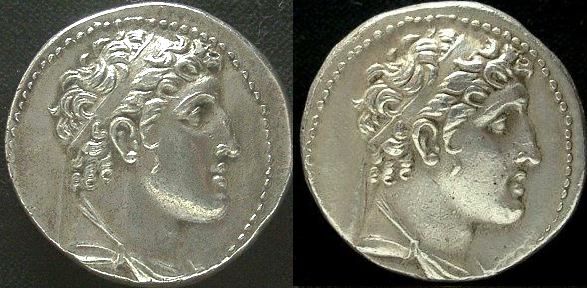
Tetradrachm of Alexander I (Balas)
The two coins shown above are both tetradrachma of Alexander I (Balas) of the Seleukid Kingdom. While there are minor differences due to die wear and striking characteristics, there is no question that they share a common obverse die. You can see this most clearly if you examine the positioning of the beading around the heads, and the irregularities in those beads relative to the other features on the portraits. A closer examination of the coins was called for, because in spite of the shared obverse die, they were struck at different mints, possibly in different years. Coin #1 on the left, is an issue of Tyre mint (Sear-7032 type). FULL IMAGE. The weight is 15.21 grams, which is almost a full gram over the correct Phonecian standard of 14.25 grams. It is dated year-165 (equal to 148-147 BC). Coin #2 on the right is an issue of Berytus mint (Sear not listed). FULL IMAGE. The weight is 13.20 grams, which is almost a full gram below the correct Phonecian standard of 14.25 grams. The date on this one is not clear, as it is not clear what the first letter in the date is, but it appears possibly to be an attempt at a GAMMA, which would make the date year-163 (equal to 150-149 BC). The basic problem is: how can two coins struck at two different mints, most likely more than a year apart, share a common obverse die? The simple answer is that it is highly unlikely and most likely not possible. That is what first drew these coins into question, however the incorrect weight standards basically proves the coins are not authentic. RELATIVE DANGERDEALERdangerous COLLECTOR EXPERIENCED very dangerous NOVICE extremely dangerous Either of these coins, on visual examination alone, would (and have) been passed as authentic even in the hands of experienced people, and thus they must be considered dangerous to even experienced dealers. The incorrect weights show them for what they really are, but one cannot always have a set of scales on hand at all times to check every purchase as one is making it. To an average collector these are very dangerous, but to a collector not familiar with the weight standards of these issues (how many realize the Phonecian mint issues were not struck to the same standard as the regular issues), they must be considered extremely dangerous. It is very likely that the dies from which these coins were struck were cut in modern day Beirut (Lebanon). I have reason to believe they may have been cut more than 20 years ago and are still in use. Any coin struck with a die match to this obverse die, or to either of the reverse dies, is certainly also fake and I would greatly appreciate hearing from anyone that has identified such die links to other dies, and can provide very good images of them. If such images become available, I will eventually post a website to illustrate them, which is by far the best way of un-masking the work of this same very talented (and dangerous) modern die cutter. As with most fakes, even very good ones, there are always features that eventually give them away, and they will be spotted for what they are. However with fakes of this quality even experienced dealers may on occasion make a mistake and sell one as genuine (I know of at least two others from this obverse die that sold at Auction in Germany earlier this year). One should accept that such mistakes can and will occasionally happen in all honesty. The measure of how reputable a dealer really is, is what he does about it once the mistake is recognized. Back to examples of fakes. Top of Page
|

